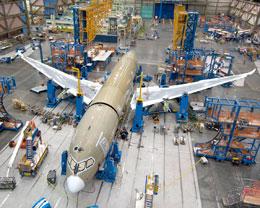More attention needed for “Made in B.C.”

Guest Commentary
By Bruce Ralston
Minister of Jobs, Trade and Technology
When people think of B.C.’s economy, mining, forestry, tourism, and our booming tech sector are often mentioned.
But there is an area of our economy that does not receive nearly as much attention as it should: manufacturing.
As the Minister for Jobs, Trade, and Technology, I have seen first-hand the work of the people who drive B.C.’s bustling manufacturing sector.
From the Peace region to the Kootenays, manufacturers are creating good jobs for British Columbians, adding value to our natural resources and raising the export value of products.
October is Manufacturing Month in B.C. when the Government of British Columbia celebrates our province’s manufacturers for their contributions to local communities and the provincial economy.
The sector is definitely on the upswing. Over the past five years, B.C. has had the second-fastest growing manufacturing sector in Canada. Manufacturing provides well-paying, high-skilled jobs to about 175,000 people in B.C., with weekly earnings that are almost 17% higher than the provincial average.
As minister, I have the privilege of seeing our manufacturers in action all around the province. The diversity of businesses in this sector is impressive.
In Kelowna, I visited KF Aerospace, which has grown to become the Okanagan’s largest private employer, and FormaShape, which is one of North America’s largest manufacturers of composite fiberglass products.
While touring the Kootenays, I stopped by Drop Designs in South Slocan, which manufactures components for the oil and gas, agriculture, forestry, and mining industries. It started 12 years ago as a one-person business, building sprockets, and now has 75 full-time employees. Drop Designs has benefited from a number of government programs and is an outstanding example of how small B.C. manufacturers can thrive by embracing technology.
In Trail, I visited Fenix Advanced Materials, which uses raw material from the town’s zinc and lead smelter to produce ultra-high-purity metals for use in the solar energy, telecommunications, and commercial and military infrared markets.
On a trip to northeastern B.C., I paid a visit to Louisiana-Pacific’s engineered-wood products facility in Dawson Creek, which is undergoing a $130-million expansion and adding 55 new jobs to its current workforce of 145.
Another great example of innovation in manufacturing is a Vancouver-based company called ChopValue. Felix Bock, founder, and CEO, and his staff of 18 recycle some of the estimated 100,000 chopsticks that are thrown away in Vancouver every day and transform them into beautiful home-décor items, such as table tops and wall pieces.
Their coasters are a conversation piece. I have a set for coffee cups in my office and guests are regularly amazed that waste materials can be converted into such elegant products. To date, ChopValue has prevented 15,000 kilograms of waste from going to the landfill.
The companies I visited demonstrate the remarkable diversity of products being produced in B.C. Whether those products come from natural resources or are fabricated, the people behind them demonstrate what can be accomplished with innovation and hard work. B.C. applauds manufacturers for developing emerging industries and recognizing that diversification is a crucial component of a healthy, stable economy.
As the manufacturing sector continues to expand, our government will continue to invest in people to create good jobs and ensure all sectors have the skilled workers they need to grow in every corner of B.C.
By the numbers
Manufacturing contributes $16.8 billion to the B.C. economy and represents about 9% of the total Canadian manufacturing gross domestic product (GDP).
In 2017, there were 174,200 people employed in the manufacturing sector in British Columbia, the third-largest share of manufacturing workers among all Canadian provinces.
There are approximately 7,200 manufacturing companies in British Columbia with at least one employee.
Workers in the sector have weekly earnings that are 16.5% higher than the provincial average.
Females represent approximately 30% of the employed labour force in the manufacturing sector of B.C.
Every 100 direct jobs in the manufacturing sector support 75 jobs in the rest of the economy.
In 2017, manufactured goods accounted for 61% of B.C.’s total goods exported to international destinations.
Manufacturers of technology products account for over 14,300 jobs and $1.6 billion of provincial GDP.
Pharmaceutical and medicine manufacturing in B.C. has increased by over 125% since 2011.
Medical equipment manufacturing exports from B.C. totalled $187 million in 2017 — an increase of 70% from 2011.
B.C. has the third-largest aerospace sector in the country, generating $1.3 billion of the province’s GDP and providing 8,300 high-skilled, well-paid jobs.









